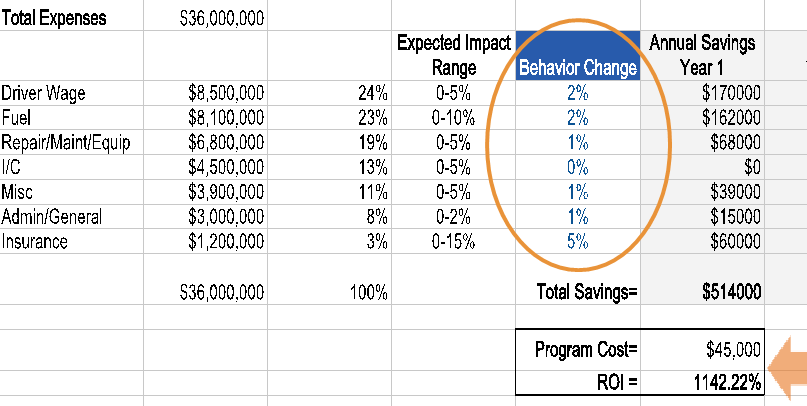ANDREA TARRELL
Director of Marketing at HNI
Data and analytics have the potential to radically change the game in transportation. One of the most effective applications is through a driver scorecard or visual dashboard, as we discussed at our webinar last week on "Big Data" Meets Performance Management for Drivers
What makes a successful driver scorecard? Here's a quick and dirty list covering the 10 things that your driver scorecard MUST have to be successful.
1. Have top down buy in
To undertake the process of developing a true a driver performance management system, you need top down commitment and dedicated resources. Think you are going to gain support of leadership after you show results? Think again.
Without your senior leadership backing the project from the beginning, you will struggle to get the resources to see the project through to completion, and you’ll fight an uphill battle to get organization-wide commitment during the roll out of your scorecard.
Building a case to "pitch" the project to senior leadership is the first step toward success.
2. Balance both safety & productivity
Drivers today are suffering from what we term “driver dyslexia” – they’re hearing one message  from safety and one from ops, and they don’t know who they should answer to.
from safety and one from ops, and they don’t know who they should answer to.
In any driver scorecard, operational metrics like productivity, late delivery, and fuel efficiency should be appropriately balanced with safety numbers like hours of service, accidents.
3. Directly link performance to YOUR profitability
If scores are going up but profitability isn’t following, something isn’t right. The best scorecards determine what metrics are related to profitability and weight them appropriately to drive the behaviors you want to see.
4. Consist of [only] measurable data points
You can only manage what you can measure. Avoid including subjective measures into your scorecard that are based on someone’s opinion. This can call scorecard results into question and leave room for manipulation of scores.
5. Not take an IT army to maintain
Your analytics need to be in the hands of the people that are accountable for driving business results -- not require a programming degree to dig out of your systems. Effective business intelligence tools incorporate self-service as much as possible and empower users to make data-driven decisions.
We typically recommend partnering with someone who can maintain the technology behind the scenes. If you have a robust IT department, you’re lucky, but most transportation companies don’t have the time or expertise in house to manage a project like this in addition to everything else that’s on their plate.
6. Be clear, easy to communicate, and actionable
You have a lot of data. But if you don’t display it in a way that people can understand, it will miss the mark. People need to be able to take one look at the scorecard and instantly have the answer to the question “how am I doing?” Use easy-to-understand tables and graphics to get your message across in a way that people can actually act on it.
[Want a look at how we recommend sharing driver performance data? Request a demo of our tool.]
7. Highlight training needs and identify high-risk profiles
Use the scorecard data to determine exactly what needs a driver has and laser focus your training on what he or she needs most. We can get them help they need before an accident or incident occurs…or before they get disgruntled and leave.
Once you start measuring scores and tracking the history for your drivers, you should be able to mine the data to identify who your riskiest employees are. With that profile, you can take action to proactively screen for those types of individuals in the hiring process.
8. Make drivers feel good about their job
A driver scorecard also highlights what your drivers are doing right. Don’t just use the scorecard to punish the laggards – use it to point out where people are succeeding and celebrate it! It’s a pretty good feeling for drivers to know when they’re top of the heap, and that satisfaction will translate into lower driver turnover and a more engaged driver population.
A scorecard totally changes the tone of most performance review conversations. It lets you sit down with drivers and talk about how they can make more money. It puts you on the driver’s side of the table and allows you to tell them how to improve without coming off as critical.
9. Save you money!
At the end of the day, if a scorecard isn’t saving you money, it’s not worth it. ROI for performance management systems can come from a number of places. Here’s a sample calculation showing some areas where companies can save:

10. Create Performance Driven Leaders in your company
With one metric to judge driver performance, there’s only one page to be on. The driver scorecard should inspire driver managers, department heads, and leaders at every level of the company to do their daily jobs with their eye glued on performance.
Many companies we’ve implemented a driver scorecard for have moved on to apply the approach in other operational areas. Sales, customer serivce, and management analytics can be a powerful way to help you manage your entire company towards greater profitability.
Interested in learning more about how a driver scorecard can transform your company?
Check out our recent webinar [recording and slide deck available here] to learn more about how "big data" can be deployed to change the way your company thinks about performance and engage drivers.
Want to see an example of the product in action? We'd be happy to show you a live demo as well! Clik
Related Posts:
Leading vs Lagging Indicators: Using Data to Predict [& Shape] The Future
What Employers Need to Know About Degenerative Disc Disease
Workplace Incident Report: 7 Immediate Steps to Take After an Injury
How Physical Abilities Testing Can Stop Your Next Work Comp Claim
How Medical Marijuana Insurance Issues Affect Your Work Comp Policies
.png?width=69&height=53&name=Acrisure%20Logo%20(White%20Horizontal).png)


